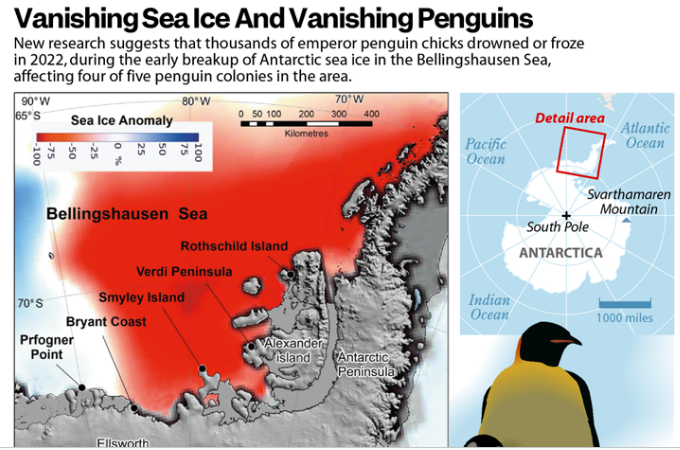Context:
According to recent study, up to 10,000 emperor penguin chicks across four colonies in Antarctica’s Bellingshausen Sea may have died as the sea ice underneath their breeding grounds melted and broke apart in late 2022.
About Emperor Penguins:
- Emperor Penguins are the largest penguins on Earth.
- They live in Antarctica, the coldest habitat on Earth.
- The emperor penguin’s body has a thick layer of blubber insulated by a thick layer of down covered by feathers.
- IUCN Status: Near Threatened
Reason for Failure of Breeding
- Antarctic Sea Ice Decline: Since 2016, the Antarctic sea ice extent — the total region with at least 15% sea-ice cover — has been shrinking with the total area of frozen water around the continent reducing to new record low levels almost every year.
 Impact: This puts more than 90% of emperor penguin colonies at risk as they may go extinct by the end of this century, if Earth continues to get warmer at the present rate.
Impact: This puts more than 90% of emperor penguin colonies at risk as they may go extinct by the end of this century, if Earth continues to get warmer at the present rate.- Stable sea ice in the emperor penguin breeding cycle is crucial for their breeding.
- Drop in Sea Ice: Although it’s currently the winter season in the Southern Hemisphere, ice growth has been really slow in Antarctica.
- Decline in Ice Sheet: Decline in the ice sheet causes a spike in sea surface temperatures as sea ice reflects solar rays back into space and thwarts heat from getting absorbed in the oceans.
- Antarctic Sea Ice Variability: Climate models show very large variability in Antarctic sea ice, because the models generally struggle to simulate the past changes in Antarctic sea ice.
Sea Around Antarctica
- Weddell Sea: The Weddell Sea is situated in the Southern Ocean, south of the Atlantic Ocean and east of the Antarctic Peninsula.
- Ross Sea: Ross Sea is the southern extension of the Southern Ocean, which, along with the vast Ross Ice Shelf at its head, makes a deep indentation in the circular continental outline of Antarctica.
|
News Source: The Indian Express
![]() 29 Aug 2023
29 Aug 2023
 Impact: This puts more than 90% of emperor penguin colonies at risk as they may go extinct by the end of this century, if Earth continues to get warmer at the present rate.
Impact: This puts more than 90% of emperor penguin colonies at risk as they may go extinct by the end of this century, if Earth continues to get warmer at the present rate.